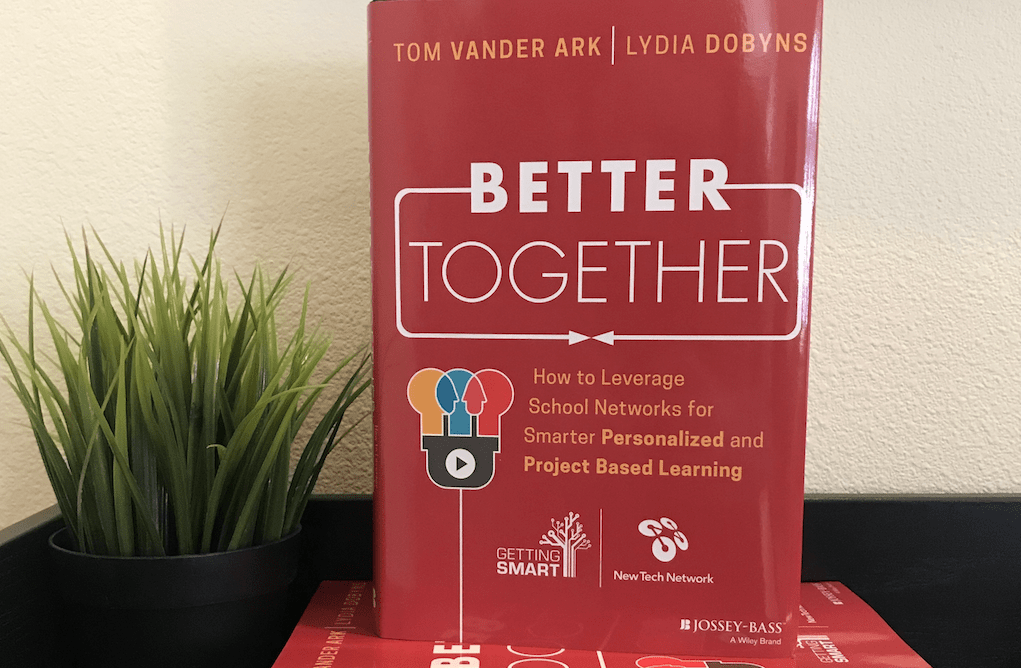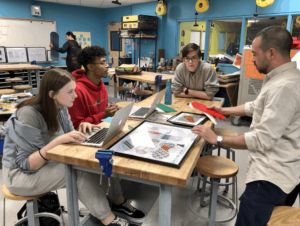Better Together: Why Schools Should Work in Networks

Three decades ago, at the end of the industrial era, it was about scale efficiency–stuff gets cheaper as you get bigger. That was true in the energy and retail, two sectors where I spent a dozen years early in my career.
Around the same time, Lydia Dobyns was helping to lay the groundwork for the information revolution, one that would change the economics of scale. She was marketing WordStar (you remember that name if you used a personal computer in the 1980s). She went on to “help create some of the first network businesses where it wasn’t just scale economies that mattered, it was a network effect, where the customer experience got better as the network got bigger and smarter.”
Her Internet consumer service was acquired by AOL. When that was acquired, she launched an early online social network (when Zuckerberg was in 2nd grade). She had an early insight that working in networks on platforms would change the world.
Two decades ago Lydia (and I) came to realize that education was the most important thing that she could work on, that there was an emerging opportunity to transform learning and attack inequity. She imagined ways that platforms and networks could extend access and opportunity.
After starting an education fund and serving on a school board, Dobyns visited Napa New Tech High School. She found the team-taught tech-powered projects compelling.
Shortly after New Tech High opened, a nonprofit was formed, New Tech Network, to scale its powerful design and learning platform. In 2010, Lydia joined as the CEO.
What started with one high school is a national network of 200 schools, a third of which are elementary and middle schools. They all share a commitment to team-taught projects and a culture of working together to solve problems that students can describe and culminating in public products and presentations.
After working with hundreds of districts and thousands of schools, Lydia and I concluded that personalized and project-based learning is powerful but challenging. It breaks a lot of old conventions and the toolset isn’t good enough to make it easy. In short, it’s hard to do well, at scale and over time.
Where personalized learning is working for kids, there is usually a network ranging from an informal collaboration to a formal governance structure. For example:
- Future Ready Schools is a lightweight network of 3,200 superintendents that have signed on to an 8 point pledge;
- Voluntary membership network like New Tech Network, Big Picture Learning, or NAF; and
- Managed networks like Summit Public Schools or Achievement First.
Making the Case for School Networks
Convicted as we are about the power of networks, Dobyns and I wrote a book about it. The core premise is that creating powerful learning is hard work and there’s no reason for teacher teams to work alone. Networks make powerful learning more routinely available.
The book is called, Better Together: How to Leverage School Networks For Smarter Personalized and Project Based Learning. Here’s the outline:
Part One: Platform Revolution
1. Platforms: A Place You Call Home
2. Network Effect: When Bigger is Better
3. Learning Platforms: When Will They Transform Education?
Part Two: Transforming Schools
4. Powerful Learning: Personalized and Project-based
5. Design Thinking: The New Frame For School
6. Connected Teaching: Technology Enables Co-creation
7. Learning Organizations: Building Collective Capacity
8. Dynamic Networks: Picking the Right Structure for Scaled Impact
Part Three: Navigating the Future…Starting Now
9. Leadership: From Compliance to Agreement Crafting
10. Impact Engines: Picking The Right Business Model
11. Governance: Use Networks to Boost Quality Options
12. Powerful Learning at Scale: Inspiration and Intermediation
13. Advocacy: A Nation Proud of Its Public Schools
The first section discusses network effects (how user experience improves with scale) in powerful networks and why most of them operate on platforms.
The second section makes the case that, in education, most powerful networks share three key ingredients: a school model, a platform, and professional learning opportunities.

The third section shows how school districts can operate like networks. In this podcast, we discussed three great Pittsburgh area districts–Avonworth, Montour, and South Fayette. They each operate like a coherent network, have formed a personalized learning network, are part of the Grable Foundation sponsored #RemakeLearning network, and belong to the League of Innovative Schools–they are networks inside networks inside other networks.
Larger districts can leverage networks as well. El Paso ISD worked with New Tech Network to develop 8 (soon to be 9) great schools that complement the district’s active learning framework.
Denver developed a crop of homegrown networks including DSST, Strive, Rocky Mountain Prep, and Beacon Schools Network. “Districts like these are becoming innovative machines,” said Dobyns.
“We’ve allowed governance to be a problem for a long time. The answer is not charter versus district, networks are best way to organize,” said Dobyns. “Schools get better when they are part of a community.”
You Need a Network Plan
“We need to completely rethink how schools are organized,” said Dobyns, “We need to leave the expert focused classroom and create student-centered environments.”
Tech is not the solution, it plays an important role, but what we really need are “new human networks” explained Dobyns.
In Better Together, Dobyns writes about dynamic networks that learn together. “The more we can predict challenges, the better the network can be a smart way to respond.”
Networks support value transactions. “The key is getting the right mix of giving and getting so that everyone benefits,” said Dobyns.
“It’s hard for individual schools to advance equity on their own” explained Dobyns. Not figuring this out is “a threat to democracy over time.” It’s time to work together in networks.
Mentioned in the Podcast
New Tech Network
Better Together: How to Leverage School Networks For Smarter Personalized and Project Based Learning, by Tom Vander Ark and Lydia Dobyns
High Tech High
New Tech High
New Tech Network
Hewlett
Big Picture Learning
EL Education
New Visions for Public Schools
Brooklyn Lab School
Kettle Moraine School District
Denver Public Schools
DSST Public Schools
STRIVE Preparatory Schools
Rocky Mountain Prep
Beacon Network Schools
League of Innovative Schools
Remake Learning
Avonworth School District
El Paso Independent School District
For more see:
- Barry Schuler on the Power of Networks (podcast)
- How the Platform Revolution is Changing Life and Learning (podcast with Sangeet Choudary)
- New Tech Network Powers A Common Learning Model & Unique Missions
Stay in-the-know with all things EdTech and innovations in learning by signing up to receive the weekly Smart Update. This post includes mentions of a Getting Smart partner. For a full list of partners, affiliate organizations and all other disclosures, please see our Partner page.








0 Comments
Leave a Comment
Your email address will not be published. All fields are required.